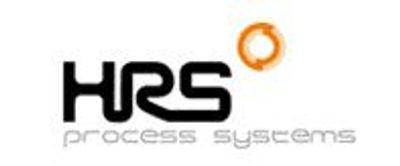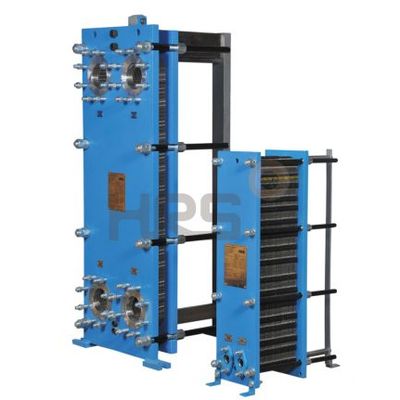


HRS Funke Gasketed Plate Heat Exchangers
HRS Process Systems Ltd. have acquired exclusive rights by the way of license manufacturing agreement for design, manufacture, supply and service of PLATE HEAT EXCHANGERS, with FUNKE Waermaustauscher GmbH! The gasketed PHE comprises of a plate pack mounted between fixed and pressure plates compressed with tightening bolts. Depending on the process requirement, variations in the passes can be designed to enable counterflow. This makes the gasketed PHE a highly efficient heat exchanger for many liquid-liquid applications such as water, oil, suspensions, chemicals, infusions, milk, juices, beverages, etc. For applications in food industry, we offer specially developed CLADDED plate heat exchangers to ensure safe processing of sensitive fluids.
All plate heat exchangers look very similar at first glance. But the difference and the secret of efficient heat transfer cannot be seen from the outside it is the wave pattern. Its performance depends on many factors, including size and number of plates. Altogether, these factors determine the size of the plate heat exchangers and the operating costs.
A crucial factor e.g. is that plates with different plate corrugation angles (in relation to the flow direction) can be combined. Obtuse corrugation angles result in longer thermal paths (H) and higher heat transfer rates but also lead to higher pressure drops. Acute corrugation (L) angles are chosen if the pressure drop must be kept low.
The heart of a PHE is a pack of embossed plates with apertures. The plates are assembled in a 180° angle to each other, resulting in flow gaps on each side. Each plate is provided with a gasket which securely seals the flow gaps from the atmosphere and separates the two media used in the heat exchanger.
Connections are on the fixed plate, but can also be on the movable plate for multipass flow.
Components of PHE:
- Fixed plate
- Movable plate
- Support column
- Carrying bar
- Lower plate guide bar
- Carrier roller
- Tightening bolt and nuts
- Fixing bolts
- Rubber liner
- Gaskets
- Heat transfer plates
- Nameplate
Technical Key Data (depending on design)
Capacity 1 KW – 30MW
Volume Flow 5 m – 4500m
Surface/Plate 0,04 m – 3,0 m
Nominal connection Diameter DN 25 – 500
Operating temperature – 20 C° – +180 C°
Working pressure max. 25 bar
Construction
Funke heat transfer plates are always produced in 1.4401 / AISI 316 as this material is generally more corrosion – resistant and more resistant to chloride damage than 1.4301/AISI 304. Depending on the design, Titanium is also available in serial production.
All plate heat exchangers look very similar at first glance. But the difference and the secret of efficient heat transfer cannot be seen from the outside it is the wave pattern. Its performance depends on many factors, including size and number of plates which determine the size of the plate heat exchangers and the operating costs. A crucial factor e.g. is that plates with different plate corrugation angles (in relation to the flow direction) can be combined. Obtuse corrugation angles result in longer thermal paths (H) and higher heat transfer rates but also lead to higher pressure drops. Acute corrugation (L) angles are chosen if the pressure drop must be kept low.
HRS Funke Plate Heat Exchangers have secured seal with number of two-pronged clips that slide beneath the plate to hold the gasket. Each plate is pressed precisely to have specially embossed entry fields in heat transfer plates for an optimum distribution of media. The gaskets have a special ribbed surface, enabling more exact centering and stabilization of the entire plate pack
-
4301/AISI 304 (cost-effective in the case of uncritical media)
-
4539/AISI 904L (with high nickel content against stress corrosion cracking, good price/performance ratio in the case of media with the low acid and chloride content)
-
4529/254 SMO (higher chloride and acid – resistance than 1.4401/ AISI 316)
-
Hastelloy (highly resistant against acids and chlorides, e.g. for concentrated sulphuric acid)
-
Titanium ASTM B 265
-
Titanium – Palladium (highest material quantity, suitable e.g. for chlorides at higher temperatures)
Depending on the design and the type, adhesive or non-adhesive (clip-system) gasket made from following sealing materials are used:
-
NBR (nitrile-butadiene rubber): Universal use for aqueous and unctuous media e.g. water/ oil applications
-
EPDM (ethylene-propylene rubber): Wide range of applications for many chemical compounds which do not contain mineral oil and grease, and for water-and steam application
-
Flororubber (viton): Extremely resistant to chemicals and organics solvents as well as sulphuric acid and vegetable oil at high temperatures.
-
Very high heat transfer rates due to thermodynamically optimized design
-
Double seal arrangement of gasket with leakage groove between two media, preventing mixing and cross contamination of media
-
Reduction in operational downtime due to glueless clip type gaskets fastened by “Clip-system” for ease of assembly and maintenance
-
Special plate profile at the edges, reinforcing the plate pack and ensuring high pressure resistance of the gasket during operation
-
Low investment, operation and maintenance costs
-
Self-cleaning effect due to highly turbulent flow behavior
-
Use of smallest temperature difference
-
Up to 75% less space required
-
Low operating weight/low liquid content
-
Easy to open/clean
-
Future additional capacity is possible by fitting extra heat transfer plates
HRS FUNKE PHE’s are used across process industries for various applications designed with compatible materials.
They find use in chemical, pharmaceutical, mechanical engineering, on and offshore sector, power, shipbuilding, compressors, piston and turbomachines, steel, surface treatment, automotive, paper and pulp, HVAC, extraction plants, HRS FUNKE PHE is used for heating and cooling of water, various type of oils, suspensions, infusion solutions, chemicals, acids etc.
In food and milk processing sector, a range of heating, cooling, pasteurization, heat recovery to milk and juices.
In key processes in these sectors, PHEs are used for heating, cooling, chilling, pasteurisation, sterilisation, condensation, heating engineering (solar heating central heating, underfloor heating) and also as vaporiser/condenser in the refrigeration plant.
